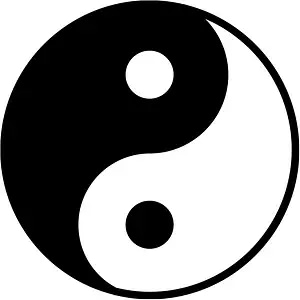The best known of the Taoist visual symbols is the Yin-Yang, also known as the Taiji symbol. The image consists of a circle divided into two tear-shaped halves, one white and the other black. Inside each half is a smaller circle of the opposite colour.
The Yin-Yang symbol and Taoist cosmology
In terms of Taoist cosmology, the circle represents the Tao, the undifferentiated unity from which all existence arises. The halves black and white within the circle represent Yin-qi and Yang-qi, the primordial feminine and masculine energies whose interaction gives life to the manifest world.the Five Elements and the Ten Thousand Things.
Yin and Yang are coexistent and interdependent
The curves and circles of the Yin-Yang symbol imply a kaleidoscope-like movement. This implicit movement represents how Yin and Yang are mutually emergent, interdependent and in continuous transformation, one into the other. One could not exist without the other, because each contains the essence of the other. Night becomes day and day becomes night. Birth becomes death, and death becomes birth. Friends become enemies and enemies become friends. As Taoism teaches, such is the nature of everything in the relative world..
Smaller circles within the larger circle
Significantly, the Yin-Yang contains smaller circles nested within each half of the symbol to serve as a constant reminder of the interdependent nature of black/white opposites. Remind the Taoist practitioner that all relative existence is in constant flux and change. And while the creation of pairs of opposites seems to be an aspect of our software human, we can maintain a relaxed attitude, knowing that each part always contains the other, as the night contains the day, or as a mother contains the child she will give birth to in time.





